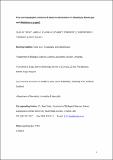Finescale topographical correlates of behavioural investment in offspring by female grey seals, Halichoerus grypus
Abstract
Grey seals breed colonially on substrates ranging from ice to rocky or sandy beaches. Clear differences in seal behaviour patterns exist among such broad classes of breeding habitat. However, finer scale topographical variation is likely to influence individual behaviour with consequences for pupping success. We examined topographical influences on the behaviour of breeding female grey seals by quantifying topography at a subseal size resolution. Using submetre resolution digital terrain models of two sites within a rocky breeding colony, we compared site topography in relation to observed differences in female behaviour at these sites. Females at both sites preferred breeding close to water (standing pools or sea) and frequently commuted between their pups and water. Topographical models indicated that one site was more costly for seals in terms of their locations and movements within the site. This was due to a lack of low-elevation land adjacent to the main access points from the sea and the reduced availability of pools. Females at this site showed reduced pup attendance and an increase in energetically costly behaviours, whilst females at the lower-cost site spent mere time interacting with their pups and resting. These topographically induced behavioural differences are likely to affect the quantity and quality of pup provisioning by mothers and influence individual pupping site selection. Less costly sites are likely to be colonized preferentially and by larger, older and more dominant females, potentially generating finescale spatial heterogeneity in female quality within the breeding colony.
Citation
Twiss , S D , Caudron , A , Pomeroy , P P , Thomas , C J & Mills , J P 2000 , ' Finescale topographical correlates of behavioural investment in offspring by female grey seals, Halichoerus grypus ' , Animal Behaviour , vol. 59 , no. 2 , pp. 327-338 . https://doi.org/10.1006/anbe.1999.1320
Publication
Animal Behaviour
Status
Peer reviewed
ISSN
0003-3472Type
Journal article
Collections
Items in the St Andrews Research Repository are protected by copyright, with all rights reserved, unless otherwise indicated.

